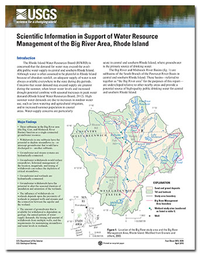Scientific information in support of water resource management of the Big River area, Rhode Island
Links
- More information: USGS Index Page
- Document: Report (1.09 MB pdf)
- Download citation as: RIS | Dublin Core
Abstract
The Rhode Island Water Resources Board (RIWRB) is concerned that the demand for water may exceed the available public water supply in central and southern Rhode Island. Although water is often assumed to be plentiful in Rhode Island because of abundant rainfall, an adequate supply of water is not always available everywhere in the state during dry periods. Concerns that water demand may exceed supply are greatest during the summer, when lower water levels and increased drought potential combine with seasonal increases in peak water demand (Rhode Island Water Resources Board, 2012). High summer water demands are due to increases in outdoor water use, such as lawn watering and agricultural irrigation, and to increased summer population in coastal areas. Water-supply concerns are particularly acute in central and southern Rhode Island, where groundwater is the primary source of drinking water.
The Big River and Mishnock River Basins are subbasins of the South Branch of the Pawtuxet River Basin in central and southern Rhode Island. These basins—referred to together as “the Big River area” for the purposes of this report—are undeveloped relative to other nearby areas and provide a potential source of high-quality public drinking water for central and southern Rhode Island.
After the severe drought of the 1960s, the State of Rhode Island acquired land in the Big River area with the intention of building a water-supply reservoir. The reservoir was not built because of concerns over potential environmental impacts and projected statewide water-supply needs (U.S. Environmental Protection Agency, 1989). The land acquired for the reservoir (13.4 mi2), called the Big River Management Area (BRMA), is currently managed by the RIWRB as a future source for public water supply and as open space. In the 1980s, the RIWRB began to consider whether the BRMA could supply water from its aquifers (groundwater). Groundwater withdrawals for public or other water-supply needs can alter the hydrologic conditions and ecologic communities of surrounding rivers, lakes, and wetlands by removing water from these systems. Consequently, the RIWRB was interested in determining optimal amounts of groundwater that could be withdrawn from the BRMA for public supply while minimizing the effects on rivers, lakes, streams, and wetlands that also rely on this water.
For nearly two decades, the RIWRB has conducted a series of cooperative studies with the U.S. Geological Survey (USGS). The goals of these studies have been to (1) evaluate and characterize the water resources of the BRMA and the greater Big River area, and (2) identify sustainable levels of groundwater use that would minimize effects on water resources. This fact sheet describes the major findings of those studies.
Study Area
| Publication type | Report |
|---|---|
| Publication Subtype | USGS Numbered Series |
| Title | Scientific information in support of water resource management of the Big River area, Rhode Island |
| Series title | Fact Sheet |
| Series number | 2015-3035 |
| DOI | 10.3133/fs20153035 |
| Year Published | 2015 |
| Language | English |
| Publisher | U.S. Geological Survey |
| Publisher location | Reston, VA |
| Contributing office(s) | Massachusetts Water Science Center, New England Water Science Center |
| Description | 6 p. |
| Country | United States |
| State | Rhode Island |
| Other Geospatial | Big River Basin, Mishnock River Basin, South Branch of the Pawtuxet River Basin |
| Online Only (Y/N) | N |
| Additional Online Files (Y/N) | N |


